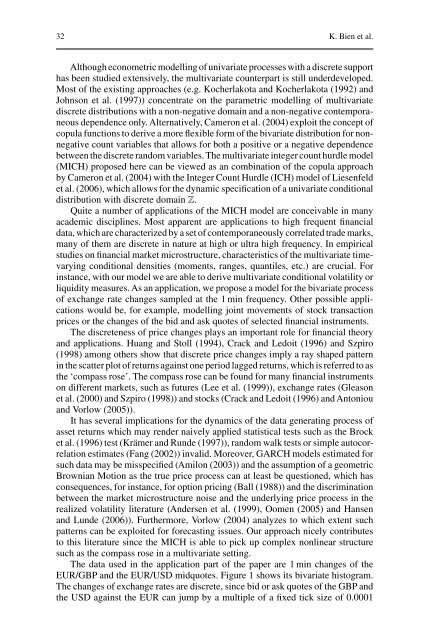recent developments in high frequency financial ... - Index of
recent developments in high frequency financial ... - Index of
recent developments in high frequency financial ... - Index of
You also want an ePaper? Increase the reach of your titles
YUMPU automatically turns print PDFs into web optimized ePapers that Google loves.
32 K. Bien et al.<br />
Although econometric modell<strong>in</strong>g <strong>of</strong> univariate processes with a discrete support<br />
has been studied extensively, the multivariate counterpart is still underdeveloped.<br />
Most <strong>of</strong> the exist<strong>in</strong>g approaches (e.g. Kocherlakota and Kocherlakota (1992) and<br />
Johnson et al. (1997)) concentrate on the parametric modell<strong>in</strong>g <strong>of</strong> multivariate<br />
discrete distributions with a non-negative doma<strong>in</strong> and a non-negative contemporaneous<br />
dependence only. Alternatively, Cameron et al. (2004) exploit the concept <strong>of</strong><br />
copula functions to derive a more flexible form <strong>of</strong> the bivariate distribution for nonnegative<br />
count variables that allows for both a positive or a negative dependence<br />
between the discrete random variables. The multivariate <strong>in</strong>teger count hurdle model<br />
(MICH) proposed here can be viewed as an comb<strong>in</strong>ation <strong>of</strong> the copula approach<br />
by Cameron et al. (2004) with the Integer Count Hurdle (ICH) model <strong>of</strong> Liesenfeld<br />
et al. (2006), which allows for the dynamic specification <strong>of</strong> a univariate conditional<br />
distribution with discrete doma<strong>in</strong> Z.<br />
Quite a number <strong>of</strong> applications <strong>of</strong> the MICH model are conceivable <strong>in</strong> many<br />
academic discipl<strong>in</strong>es. Most apparent are applications to <strong>high</strong> frequent f<strong>in</strong>ancial<br />
data, which are characterized by a set <strong>of</strong> contemporaneously correlated trade marks,<br />
many <strong>of</strong> them are discrete <strong>in</strong> nature at <strong>high</strong> or ultra <strong>high</strong> <strong>frequency</strong>. In empirical<br />
studies on f<strong>in</strong>ancial market microstructure, characteristics <strong>of</strong> the multivariate timevary<strong>in</strong>g<br />
conditional densities (moments, ranges, quantiles, etc.) are crucial. For<br />
<strong>in</strong>stance, with our model we are able to derive multivariate conditional volatility or<br />
liquidity measures. As an application, we propose a model for the bivariate process<br />
<strong>of</strong> exchange rate changes sampled at the 1 m<strong>in</strong> <strong>frequency</strong>. Other possible applications<br />
would be, for example, modell<strong>in</strong>g jo<strong>in</strong>t movements <strong>of</strong> stock transaction<br />
prices or the changes <strong>of</strong> the bid and ask quotes <strong>of</strong> selected f<strong>in</strong>ancial <strong>in</strong>struments.<br />
The discreteness <strong>of</strong> price changes plays an important role for f<strong>in</strong>ancial theory<br />
and applications. Huang and Stoll (1994), Crack and Ledoit (1996) and Szpiro<br />
(1998) among others show that discrete price changes imply a ray shaped pattern<br />
<strong>in</strong> the scatter plot <strong>of</strong> returns aga<strong>in</strong>st one period lagged returns, which is referred to as<br />
the ‘compass rose’. The compass rose can be found for many f<strong>in</strong>ancial <strong>in</strong>struments<br />
on different markets, such as futures (Lee et al. (1999)), exchange rates (Gleason<br />
et al. (2000) and Szpiro (1998)) and stocks (Crack and Ledoit (1996) and Antoniou<br />
and Vorlow (2005)).<br />
It has several implications for the dynamics <strong>of</strong> the data generat<strong>in</strong>g process <strong>of</strong><br />
asset returns which may render naively applied statistical tests such as the Brock<br />
et al. (1996) test (Krämer and Runde (1997)), random walk tests or simple autocorrelation<br />
estimates (Fang (2002)) <strong>in</strong>valid. Moreover, GARCH models estimated for<br />
such data may be misspecified (Amilon (2003)) and the assumption <strong>of</strong> a geometric<br />
Brownian Motion as the true price process can at least be questioned, which has<br />
consequences, for <strong>in</strong>stance, for option pric<strong>in</strong>g (Ball (1988)) and the discrim<strong>in</strong>ation<br />
between the market microstructure noise and the underly<strong>in</strong>g price process <strong>in</strong> the<br />
realized volatility literature (Andersen et al. (1999), Oomen (2005) and Hansen<br />
and Lunde (2006)). Furthermore, Vorlow (2004) analyzes to which extent such<br />
patterns can be exploited for forecast<strong>in</strong>g issues. Our approach nicely contributes<br />
to this literature s<strong>in</strong>ce the MICH is able to pick up complex nonl<strong>in</strong>ear structure<br />
such as the compass rose <strong>in</strong> a multivariate sett<strong>in</strong>g.<br />
The data used <strong>in</strong> the application part <strong>of</strong> the paper are 1 m<strong>in</strong> changes <strong>of</strong> the<br />
EUR/GBP and the EUR/USD midquotes. Figure 1 shows its bivariate histogram.<br />
The changes <strong>of</strong> exchange rates are discrete, s<strong>in</strong>ce bid or ask quotes <strong>of</strong> the GBP and<br />
the USD aga<strong>in</strong>st the EUR can jump by a multiple <strong>of</strong> a fixed tick size <strong>of</strong> 0.0001










